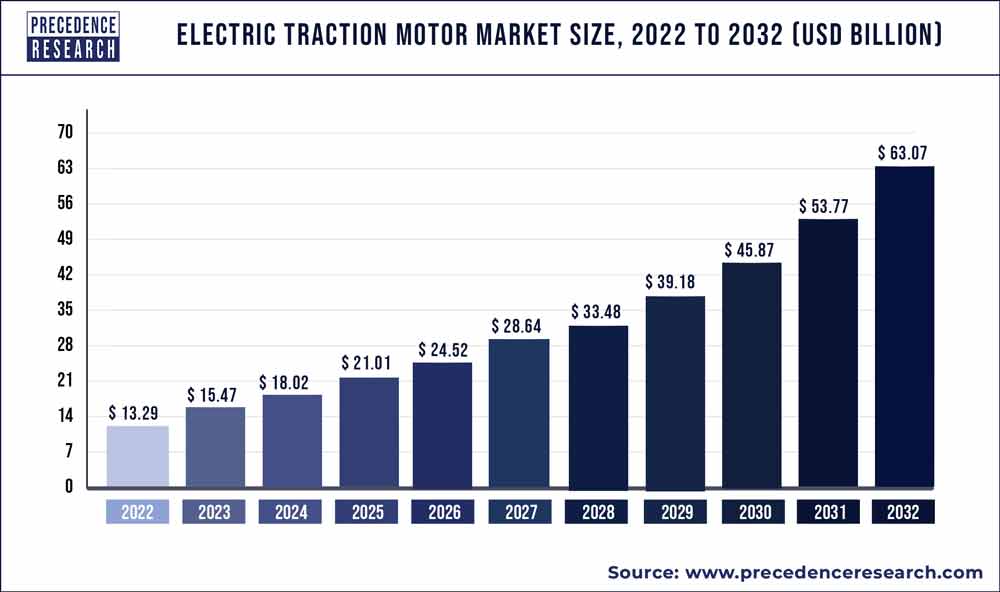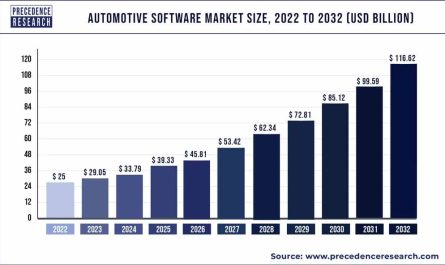The electric traction motor market which was USD 13.29 billion in 2022, would rocket up to USD 63.07 billion by 2032, and is expected to undergo a CAGR of 16.9% between 2023 to 2032.

The rise in investments in the railway industry, favourable government regulations and subsidies, and the rising need for high-performance motors are all expected to fuel the electric traction motors market expansion.
For vehicle propulsion, an electric traction motor is employed. On a machine, it is utilised to create rotational torque, which is then converted to straight-line motion. Using the driving gear unit and axle, the motor’s turning force is transmitted to the wheels.
Get the Sample Copy of Report@ https://www.precedenceresearch.com/sample/2160
An electric traction motor can be used to power an electric car or locomotive. Elevators, trolleys, and conveyors as well as electric-powered railway cars employ them. They are capable of driving large industrial gear. Such motors provide a number of benefits, including minimal noise and less maintenance requirements. They are also highly reliable and have straightforward construction. The motor doesn’t emit smoke, making it a good choice for underground transportation services.
Regional Snapshots
The Asia Pacific will continue to dominate the market for electric traction systems for the foreseeable year. The global market for electric traction systems in this sector is expected to rise as transportation infrastructure develops, including railway connections, hybrid electric automobiles, high-speed bullet trains, and metro rail systems. Rising demand for narrow gauge, including, hybrid, diesel-electric, and electric locomotives, is expected to contribute considerably to market share over the projection year.
Key Insights:
- By type, AC segment has accounted market share of over 87% in 2021.
- DC segment has contributed revenue share of over 13% in 2021.
- Asia Pacific has dominated the market with a revenue share of over 48% in 2021.
Read More: Automotive Artificial Intelligence (AI) Market is Amped up and on the Rise
Report highlights
- Thanks to contemporary power electronics, AC motors are now preferable. When compared to their DC equivalents, they are more effective and provide simpler control. Thus, it is anticipated that AC motors would continue to dominate market growth.
- Electric traction motors, which provide superior speed control and start-up torque, are a crucial component of railroad trains. In the upcoming years, the railway application sector is anticipated to dominate the market.
- The market for electric traction motors in Asia Pacific is anticipated to grow significantly by 2030s end. The expansion is anticipated to result from an increase in the use of electric vehicles (EVs) as well as a significant number of rail and metro projects in the continent’s growing nations, including China, India, Japan, and others.
- In the foreseeable future, further product applications in the EV category would also help market expansion. The market for electric cars is rapidly growing, mostly due to rising fossil fuel prices and government incentives for purchasing EVs.
Recent developments
- Mercedes-Benz will acquire YASA Motors Ltd., which is a pioneer in next-generation electric powertrain technologies, in the month of July 2021. As per the terms and conditions of the purchase, YASA will manage its own Mercedes-Benz subsidiary, creating high-performance electric motors.
- In 2017, ABB Limited purchased KEYMILE Group’s mission-critical communication business unit. ABB Limited is a multinational enterprise with experience in power, automation technologies, robotics and heavy electrical equipment. This acquisition focuses to broaden ABB’s offering of communication networks. This will also help ABB’s revenue-generating prospects increase.
- In the month of December 2020, Parker-Hannifin introduced a new high power, GVM310 permanent magnet AC motor with a 310 mm frame. This new model will be added to the Global Vehicle Motor (GVM) range of off-road and on-road commercial electric and hybrid vehicles.
Electric Traction Motor Market dynamics
Drivers
One of the key factors fuelling the expansion of the electric traction motor market is the increasingly stringent pollution laws that OEMs are being forced to produce and sell electric and hybrid cars. Day by day, there are more and more worries about the damaging impacts of various modes of transportation on the environment, such as air pollution. Automobile manufacturers have been compelled to create automobiles that adhere to local regulatory norms as a result of growing environmental pollution concerns.
The International Energy Agency (IEA) estimates that by 2020, there will be 10 million electric cars on the road globally, with battery electric vehicles (BEVs) making up two-thirds of the fleet. With registrations tripling to 1.4 million (10% sales share) in 2020, Europe had the greatest growth, becoming the world’s largest market for electric vehicles for the first time. With 1.2 million registrations, China finished in second (5.7% of total sales), while the US followed in third (2% of sales) with 295,000 registrations. Several factors have contributed to the rise in popularity of electric and hybrid vehicles. The popularity of electric and hybrid cars has been fuelled in part by government subsidies, zero emissions, improvements in battery technology, and improved user experiences. Sales of electric cars including BEVs, HEVs, and PHEVs have surged as a result of the stricter pollution regulations.
Automated systems have taken the role of mechanical links as a result of vehicle electrification. For instance, the rising use of 48-volt electrical systems in automobiles has increased the demand for powerful electric traction motors to provide the necessary power requirements. The motor business has been directly impacted by the rise in electric car sales, which bodes well for the future of the electric traction motor market.
Restraints
Electric traction motor market growth is being hampered by the high initial deployment costs in the rail industry. Deploying railroads, including locomotives, metros, trams, and other types, comes at a relatively high initial cost. Setting up field-level devices and equipment with new technology involves a sizable initial expenditure. Setting up the sophisticated infrastructure for organising transmission networks and administering new and current systems also incurs significant costs. Railway officials are also quite concerned about the significant operational and maintenance expenses following implementation.
Budget restrictions on the railroad prevent the government and commercial parties from implementing cutting-edge railway technology and solutions. Therefore, it is anticipated that the high initial cost of establishing railroads with cutting-edge technologies and solutions, such as electric traction motors, would restrain the market’s expansion in the next years.
Opportunities
Due to changing fuel prices and the growing need to reduce CO2 emissions, the number of electric and hybrid vehicles is fast increasing. Nearly 40% of American automobile owners named fuel economy as the most important factor in increasing the efficiency of their vehicles, according to the Automotive Fuel Economy Survey. The International Energy Agency (IEA) estimates that around 10 million electric vehicles were sold globally in 2020, an increase of 63% from the year before. Over 95% of the world’s supply of electric two- and three-wheelers comes from China. The World Health Organization (WHO) reports that China is making major efforts to address air pollution, which causes around 1 million fatalities annually. By making the required adjustments in the automobile industry to fulfil the air quality criteria established by the government, the nation is concentrating on managing air pollution and lowering carbon emissions. Aside from China, which has a sizable percentage of electric vehicles on the road, most nations in the world are seeing an increase in demand for electric automobiles.
Challenges
By degrading the winding insulation in electric motors, excessive heat brought on by overheating can lead to motor failure. Overload, inadequate power conditions, extremely effective service factors, frequent turning on and off of the motor, and a lack of airflow around the motor are all causes of overheating. In hot climates, electric motors also frequently overheat. Insulation failure is the cause of around 30% of all motor failures, while overheating is the cause of about 60%. Significant dependability problems plague permanent magnet motors; when subjected to high temperatures, these motors lose their magnetic. These motors’ permanent magnets demagnetize, which lowers their torque capacity. Electric motors must thus function optimally to meet this task. Therefore, spaces with functioning electric motors require the installation of suitable cooling and ventilation systems.
Electric Traction Motor Market Segmentation
By Vehicle Type
- Plug-in Hybrid Electric Vehicles
- Mild Hybrid Vehicles
- Full Hybrid Vehicles
By Type
- AC
- DC
By Power Rating
- Below 200 KW
- 200 KW To 400 KW
- Above 400 K W
By Application
- Railways
- Electric Vehicles
- Elevators
- Conveyors
- Industrial Machinery
- Others
By Geography
- North America
- Europe
- Asia-Pacific
- Latin America
- Middle East & Africa (MEA)
You can place an order or ask any questions, please feel free to contact at sales@precedenceresearch.com | +1 9197 992 333
About Us
Precedence Research is a worldwide market research and consulting organization. We give unmatched nature of offering to our customers present all around the globe across industry verticals. Precedence Research has expertise in giving deep-dive market insight along with market intelligence to our customers spread crosswise over various undertakings. We are obliged to serve our different client base present over the enterprises of medicinal services, healthcare, innovation, next-gen technologies, semi-conductors, chemicals, automotive, and aerospace & defense, among different ventures present globally.

